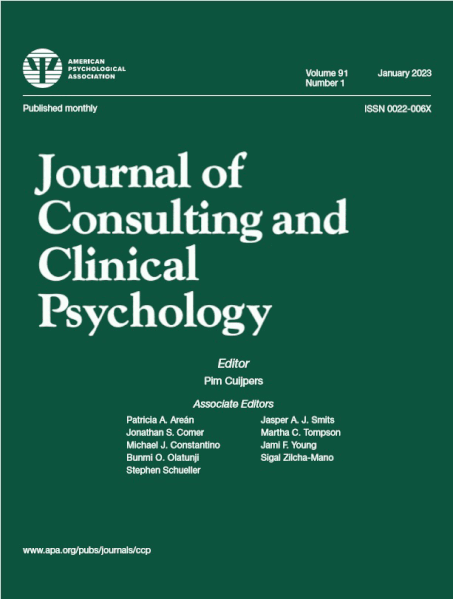超越总分:用项目水平分数增强心理治疗结果预测。
IF 5
1区 心理学
Q1 PSYCHOLOGY, CLINICAL
引用次数: 0
摘要
目的通过对项目级数据的整合,优化辍学和治疗无反应预防模型的预测性能,提高辍学和治疗无反应预防水平。方法1277例患者的常规资料(Mage = 36.95, SDage = 13.64;在osnabrck大学接受治疗的64.77%女性)用于训练和评估20个机器学习算法和5个集成模型。测量方法包括社会人口学信息、结局问卷-30、心理治疗进展评价问卷、情绪幸福感问卷、症状量表-90- r和人际关系问题量表-32。预测模型用嵌套交叉验证进行训练,并在不接受的样本中进行验证。提取SHapley加性解释值以获得最佳结果模型。结果sitem水平模型对治疗无反应(F1-Score = 0.60, Brier评分= 0.1646,平衡精度= 0.72)和治疗无反应(F1-Score = 0.87, Brier评分= 0.0529,平衡精度= 0.88)的预测均达到最高水平。分别反映认知和身体维度的项目成为关键的预测因素。结论本研究证明了使用项目级数据来增强对辍学和治疗无反应的预测建模的临床价值,并有可能为临床实践提供可操作的见解。将这些模型整合到临床反馈系统中可以帮助识别高危患者,减少辍学率和无反应率。(PsycInfo Database Record (c) 2025 APA,版权所有)。本文章由计算机程序翻译,如有差异,请以英文原文为准。
Beyond total scores: Enhancing psychotherapy outcome prediction with item-level scores.
OBJECTIVE
This study aims at improving dropout and treatment nonresponse prevention by optimizing the performance of models for their prediction through the integration of item-level data.
METHOD
Routine data from 1,277 patients (Mage = 36.95, SDage = 13.64; 64.77% female) treated at Osnabrück University was used to train and evaluate 20 machine-learning algorithms and five ensemble models. Measures included sociodemographic information, Outcome Questionnaire-30, Questionnaire for the Evaluation of Psychotherapeutic Progress, Questionnaire on Emotional Well-Being, Symptom Checklist-90-R, and the Inventory of Interpersonal Problems-32. Prediction models were trained with nested cross-validation and validated in a holdout sample. SHapley Additive exPlanations values were extracted for the best resulting model.
RESULTS
Item-level models achieved the highest performance for both dropout (F1-Score = 0.87, Brier score = 0.0529, balanced accuracy = 0.88) and treatment nonresponse (F1-Score = 0.60, Brier score = 0.1646, balanced accuracy = 0.72) prediction. Items reflecting cognitive and bodily dimensions, respectively, emerged as key predictors.
CONCLUSION
This study demonstrates the clinical value of using item-level data to enhance predictive modeling for dropout and treatment nonresponse and the potential to provide actionable insights for clinical practice. Integrating such models into clinical feedback systems could help identify at-risk patients and reduce dropout and nonresponse rates. (PsycInfo Database Record (c) 2025 APA, all rights reserved).
求助全文
通过发布文献求助,成功后即可免费获取论文全文。
去求助
来源期刊

Journal of consulting and clinical psychology
PSYCHOLOGY, CLINICAL-
CiteScore
9.00
自引率
3.40%
发文量
94
期刊介绍:
The Journal of Consulting and Clinical Psychology® (JCCP) publishes original contributions on the following topics: the development, validity, and use of techniques of diagnosis and treatment of disordered behaviorstudies of a variety of populations that have clinical interest, including but not limited to medical patients, ethnic minorities, persons with serious mental illness, and community samplesstudies that have a cross-cultural or demographic focus and are of interest for treating behavior disordersstudies of personality and of its assessment and development where these have a clear bearing on problems of clinical dysfunction and treatmentstudies of gender, ethnicity, or sexual orientation that have a clear bearing on diagnosis, assessment, and treatmentstudies of psychosocial aspects of health behaviors. Studies that focus on populations that fall anywhere within the lifespan are considered. JCCP welcomes submissions on treatment and prevention in all areas of clinical and clinical–health psychology and especially on topics that appeal to a broad clinical–scientist and practitioner audience. JCCP encourages the submission of theory–based interventions, studies that investigate mechanisms of change, and studies of the effectiveness of treatments in real-world settings. JCCP recommends that authors of clinical trials pre-register their studies with an appropriate clinical trial registry (e.g., ClinicalTrials.gov, ClinicalTrialsRegister.eu) though both registered and unregistered trials will continue to be considered at this time.
 求助内容:
求助内容: 应助结果提醒方式:
应助结果提醒方式:


